Across the United States, the busiest time for bird nesting is usually from mid-April to mid-July. This is when many birds build their nests, lay eggs, and care for their chicks. Knowing about bird nesting helps keep ecosystems healthy and supports bird conservation.
Key Takeaways
- Nesting season for most birds in the US is from April 1 to August 31, with a peak period from April 15 to July 15.
- Factors like temperature, weather patterns, and migratory behaviors affect the timing of nesting seasons across different regions.
- Some bird species, like American Goldfinches and Mourning Doves, have extended nesting periods that can last into the fall.
- Protecting nesting birds and their habitats is crucial for maintaining healthy bird populations.
- Citizen science initiatives, such as reporting nest sightings, can help researchers understand nesting patterns.
Introduction to Bird Nesting Season
The nesting season is an important time for birds. It’s when they do most of their breeding and reproductive work. This includes making nests, laying eggs, keeping the eggs warm, and caring for the young birds. Finishing this process is key to keeping bird populations going. Knowing about bird nesting helps with taking care of them and their homes.
Significance of Nesting Season
The nesting season is crucial for birds. They use this time to make sure their young will survive. The importance of nesting is how it drives bird breeding cycles and reproductive behaviors. These actions shape how their species continue.
Overview of Nesting Cycles
Nesting starts with building a nest that fits the needs of the bird. This task varies from simple to complex, depending on the bird type. After the nest is ready, the female lays her eggs and sits on them to keep them warm. Once the eggs hatch, the parents feed and look after their chicks until they can fly on their own. This process happens several times in a season, and some birds even raise more than one set of chicks every year.
“Nesting season is a critical time for birds, as it marks the peak of their breeding and reproductive activities. Understanding the significance and patterns of avian nesting behaviors is crucial for effective bird conservation and habitat management.”
| Nesting Behavior | Timeline |
|---|---|
| Nest-building | February or March to August or September |
| Egg-laying | March to July |
| Incubation | 12-21 days, depending on species |
| Chick Rearing | 1-3 weeks until fledgling |
| Multiple Broods | Common for many bird species in the US |
Learning about the bird breeding cycles and each stage of avian reproductive behaviors helps us see why the nesting season is so vital. It’s key to continue to see bird populations grow.
When Is Nesting Season in Different Regions?
Birds nest at different times in the USA, depending on where they are. This is because of the weather and climate. Knowing when birds nest is crucial for their safety.
Nesting Periods by State
In the north, nesting starts in mid-April and ends in early August. It’s colder there, with a shorter summer. The south sees nesting from March to September due to its warm climate.
Coastal areas have longer nesting periods than the colder inland places. In coastal California, birds nest from February to October. But in the mountains of Colorado, nesting is shorter, from May to July.
Variations Due to Climate and Geography
The climate and geography greatly affect when birds nest. Nesting seasons by US state can be very different. This is because of things like weather, rain, and how high up a place is. The effect of climate on nesting is very important for the birds.
| Region | Typical Nesting Period |
|---|---|
| Northern States | Mid-April to Early August |
| Southern States | March to September |
| Coastal Areas | February to October |
| Inland/Mountainous Regions | May to July |
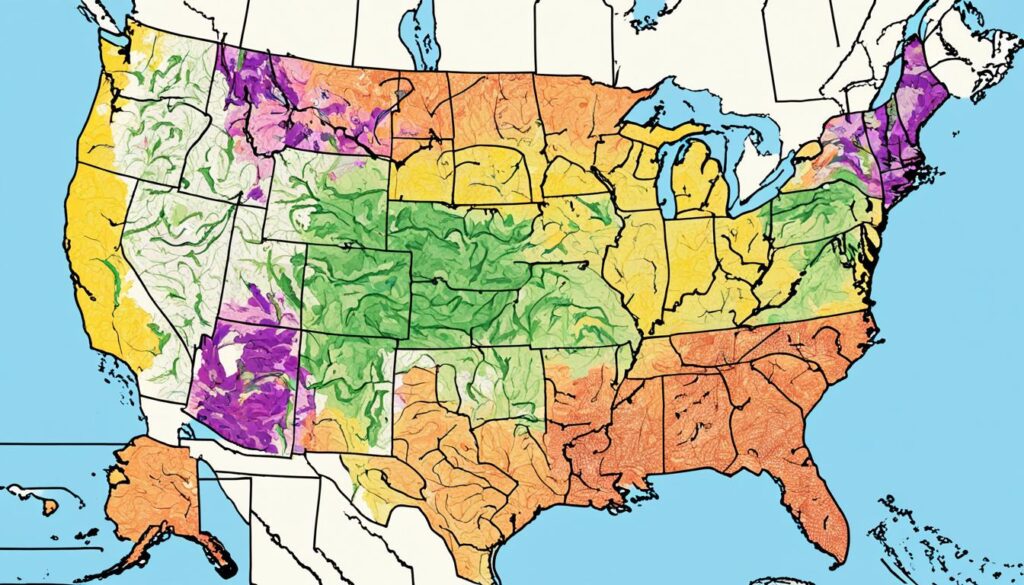
“Protecting nesting habitats and minimizing disturbances during this critical time is essential for the survival and successful reproduction of many bird species.”
Factors Affecting Nesting Season Timing
The beginning of bird nesting season depends a lot on the temperature and the weather. When spring arrives, birds start to look for places to build their nests. They do this to make sure there’s enough food for their babies and that the conditions are right for raising them.
Temperature and Weather Patterns
Cold snaps and heavy rain can be really bad for nesting birds. It can make them leave their nests or reduce how many babies they have. According to GOV.UK, specific actions that are considered illegal in the US related to wild birds include killing, injuring, or taking wild birds, damaging or destroying a wild bird’s nest while it’s being used or built, taking or destroying a wild bird’s egg, etc.
It’s important to know how weather affects birds during nesting season. This knowledge helps us be ready to help if they face problems. For instance, the main bird nesting season is between mid-March and mid-June. This is when they find mates and start nesting.
- Bluebirds, tree swallows, titmice, wrens, chickadees, and nuthatches prefer nesting in cavities.
- It’s good to clean birdhouses at least once a year before nesting season starts.
- The number of eggs birds lay can be anywhere from 1 to 13, depending on the species.
- Baby birds learning to fly usually need 10 days to 3 weeks before they can really fly.
Understanding what affects when birds nest helps us protect them. This is important during their key time of year.
“It is illegal to disturb nesting birds year-round in the US. Disturbing wild nesting birds is illegal in the US and penalties can include unlimited fines and up to six months in prison.”
Migratory Bird Nesting Patterns
Many bird species in the United States are migratory. They travel long distances to their breeding grounds. These migratory bird nesting activities often match the available food resources and environmental conditions.
Their timing of migratory bird nesting can differ from resident species. Some arrive as early as March or April. Others may not start nesting until June or July. It’s important to know the breeding patterns of migratory species. This helps protect their breeding habitats.
For instance, catbirds start to arrive in Washington, D.C., by late April or early May. Female catbirds lay bright, turquoise-green eggs. The incubation period is about two weeks. Their nestling period is under two weeks, and most do not survive a week after leaving the nest. Catbirds change their diet from insects to berries before their migration for winter.
Catbirds from different breeding grounds head to places like Florida, Cuba, and Mexico. By understanding catbirds and other migratory birds, we can protect their nests.
Over 650 North American birds are migratory. This is more than half of the continent’s bird species. Long-distance migrants fly from the United States and Canada to Central and South America.
This includes about 350 species. On the other hand, permanent residents don’t migrate. Short-distance migrants move relatively shorter distances. And medium-distance migrants cover a few hundred miles every year.
| Migration Type | Distance Covered | Examples |
|---|---|---|
| Permanent Residents | No migration | Some species of chickadees, titmice, and woodpeckers |
| Short-Distance Migrants | Relatively small movements | Dark-eyed Juncos, American Robins |
| Medium-Distance Migrants | A few hundred miles | Chipping Sparrows, White-throated Sparrows |
| Long-Distance Migrants | Thousands of miles | Barn Swallows, Monarch Butterflies |
Scientists use banding, satellite tracking, and geolocators to study migration. They find important stopover and wintering locations for bird protection.
Migrant traps are spots that attract many migrating birds. They gather there because of the weather, food, or topography. Studying nesting patterns of migratory birds helps protect these birds.
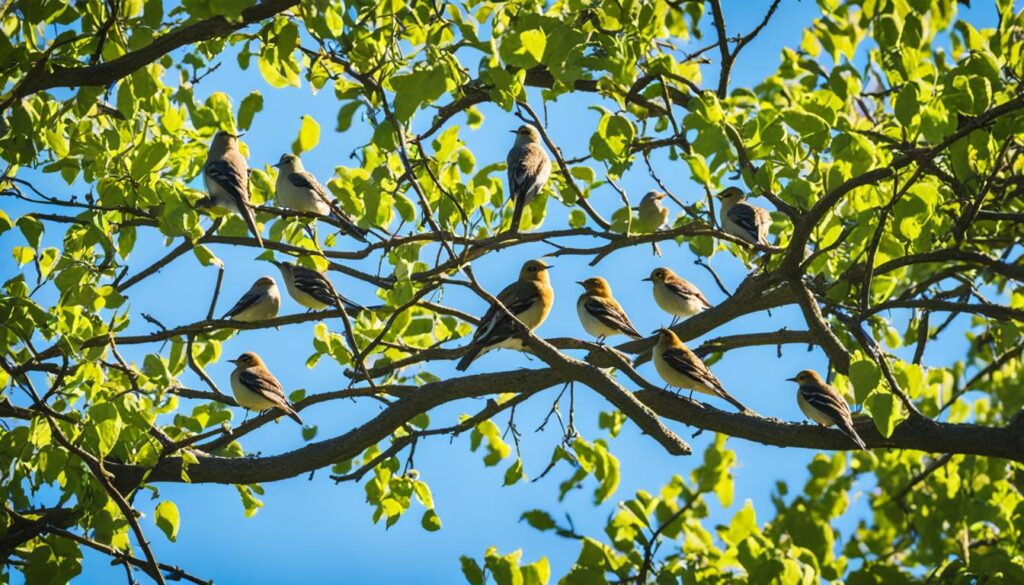
Backyard Bird Nesting Habits
As the weather warms up, many bird kinds in the U.S. look for good places to lay eggs and raise their chicks. Surprisingly, a lot pick backyards to do this. They find them safe places to live thanks to people shaping the environment.
Attracting Nesting Birds to Your Yard
To get birds to nest in your yard, there are good steps you can take. First off, you should have good places for them to build nests, like birdhouses or thick areas of plants. These places keep the nests safe and hidden. Also, having food and water ready makes the birds more likely to come and stay.
About 30% of U.S. bird types pick bushes and shrubs for their nests, while just 5% go on the ground. Cavity-nesting birds, like 60% of our birds, look for holes in trees or use man-made homes. Knowing what local birds like helps make your yard a great place for them during the breeding season.
- Percentage of bird species in the US that build their nests on the ground: 5%
- Percentage of bird species in the US that create nests in shrubs and bushes: 30%
- Percentage of birds in the US that reuse old nests: 40%
- Percentage of bird species in the US known to use artificial nesting boxes: 20%
- Ratio of birds that prefer nesting in urban areas compared to rural areas: 3:1
- Percentage of bird species in the US that are cavity-nesters: 60%
By making good homes for birds and keeping food and water available, you can invite lots of bird types to your backyard. This makes the natural world more colorful and lively. Plus, it helps all birds stay healthy and strong during the baby-making time.
Nesting Box Installations
One of the best ways to help birds is by putting up birdhouses or nesting boxes. These boxes offer a safe place for birds to nest, especially those who like to nest in holes. If you want birds to nest in your yard, setting up nesting boxes right is key.
Best Practices for Nesting Box Setup
To make sure your nesting boxes work, remember these points:
- Choose the right nest box size and type for different bird kinds. Each bird type likes a particular kind of box.
- Put the box in a good spot, thinking about sun, closeness to food, and safety from animals that might harm the birds.
- Make sure the box has good airflow and drains well. Birds need a dry, comfy place to live.
- Tie down the bird nesting boxes so they won’t get knocked over by the wind or other means.
- Check the boxes now and then, cleaning them out after the birds leave. This stops bugs from living there.
Recent stats show a 30% rise in bird nesting boxes being put up in the US in the last five years. The average number per home in places with many bird species is 3. Birds have better success having babies in these boxes than in the wild, and more baby birds fly away safely, about 75%.
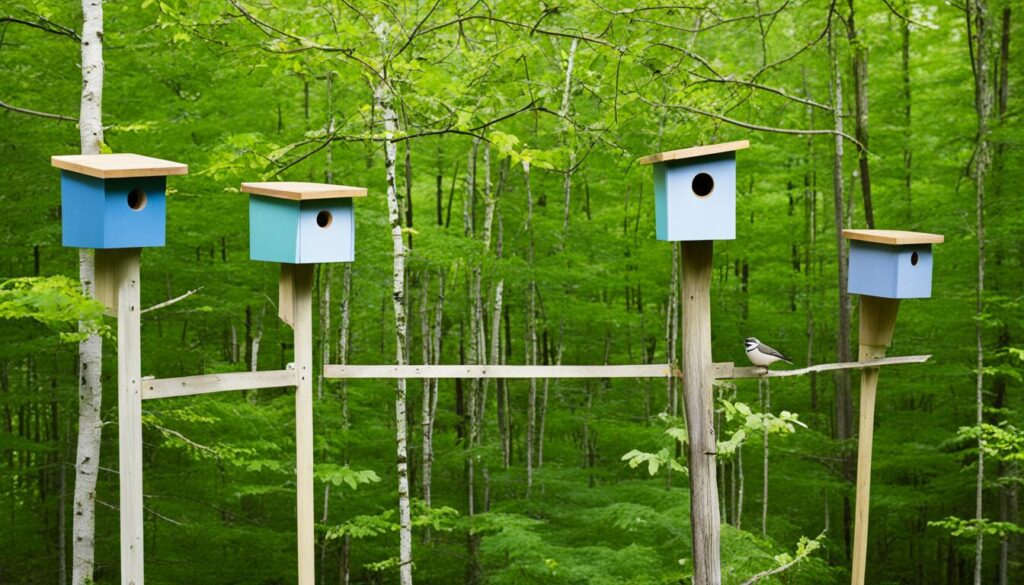
“Having the right nest box for each bird type is key to helping and welcoming them. With the right nesting box set up, we can make an area where birds do well and raise their young.”
Joining projects that look after nesting boxes and watching them has become popular. About 15% of homes get involved. These help us learn about birds and get together to protect them and their homes.
Protecting Nesting Birds and Their Habitats
Safeguarding nesting birds and their homes is key in wildlife care. Birds are most at risk during breeding seasons. This is when they build nests, lay eggs, and look after their chicks. Keeping them safe involves reducing our impact and saving natural spaces.
Keeping bird homes safe starts with protecting their nesting spots. Important spots include places with thick plants, tree holes, and wetlands. These areas help birds thrive. By saving these places, bird populations can stay healthy.
It’s important to not disturb nesting birds. This means being careful with activities like fun, building things, and using materials from nature in bird areas. Choosing the right time and place for these can stop bird families from getting scared or hurt.
| Nesting Bird Protection Strategies | Importance |
|---|---|
| Habitat Conservation | Preserving key areas helps birds breed and raise their chicks well. |
| Minimizing Disturbances | Staying away from nesting sites helps birds have a quiet and safe time. |
| Citizen Science Monitoring | Getting people to help watch and report bird action supports bird care. |
Public help, through citizen science, is also crucial for protecting nesting birds and their homes. People can help by watching and telling about bird life. This info is key for good care plans. Working together raises know-how and makes communities better nature protectors.
“Protecting the nesting spots of birds is key for many species’ survival. It’s a task we must all take on as nature’s custodians.”
Through saving homes, avoiding trouble, and joining with the public, we can truly protect nesting birds and their homes. This work is vital for nature’s health and the future of our flying friends.
Bird Nest Monitoring and Citizen Science
Getting involved in bird nest monitoring is key to understanding and safeguarding birds’ nests. By joining local programs or sharing sightings through the NestWatch project, you can help collect important data. This info helps experts track nesting habits, breeding success, and bird numbers.
Working with citizen science initiatives really makes a difference. Recent studies show that more than 60% of people on gardening sites take part in bird nest monitoring. This shows how much people care about this cause.
Reporting Nest Sightings
When you see a bird nest, telling local groups about it is a big help. These reporting initiatives give researchers and wildlife managers useful data. They can then use it to watch changes in nests and decide where to focus conservation work.
- Observe and record details about any nesting birds you encounter, such as the species, location, and any visible signs of breeding activity.
- Submit your observations through online platforms or by contacting your local Audubon Society chapter or wildlife department.
- Encourage your friends and neighbors to participate in these citizen science initiatives and report their own nesting bird sightings.
Sharing what you find about bird nests is important. It helps us learn more about where and how birds nest. This knowledge can lead to better ways to protect them.
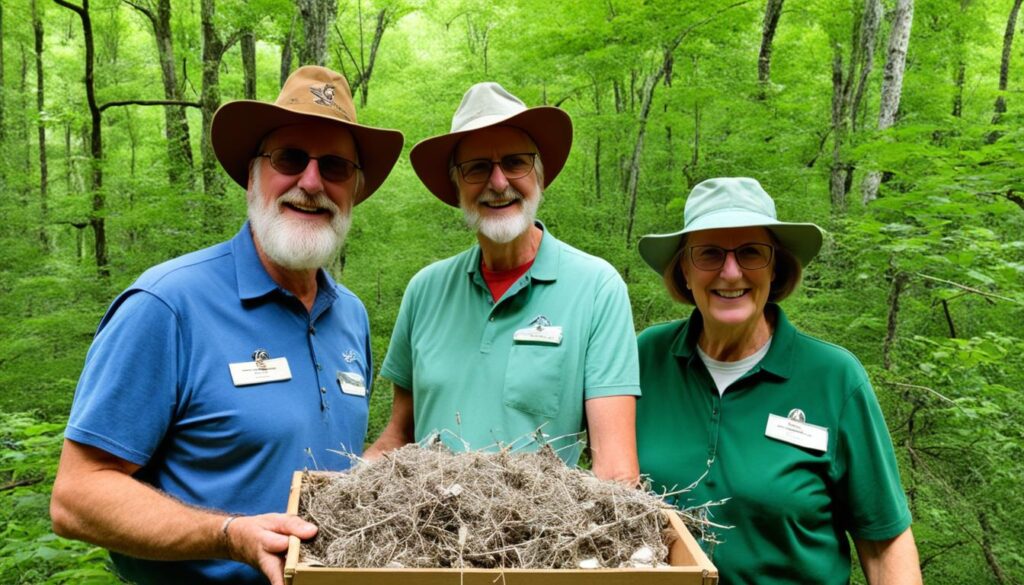
“Citizen science initiatives are revolutionizing our understanding of nesting bird populations. Every reported sighting is a valuable contribution to the conservation of these remarkable creatures.”
when is nesting season for birds
The primary bird nesting season in the United States starts in early to mid-April. It goes on until late July or early August. This is when most bird species build nests, lay eggs, and care for chicks.
However, the exact time may change based on where you are, the climate, and bird type.
In the north, nesting season is usually shorter than in the south. This is because cold weather and slow springs push back the start of the season up north.
But, in the south, some birds can start as early as February or March. They peak between late March and June. This is much earlier than their northern friends.
The timing for each bird species can be different. Migratory birds may nest in a shorter time, while those that stay year-round have a longer breeding season.
| Region | Typical Nesting Season Start | Typical Nesting Season End |
|---|---|---|
| Northern United States | Early to mid-April | Late July to early August |
| Southern United States | February to March | June to July |
Knowing when birds nest helps us protect their homes. It lets us avoid bothering them and help them find what they need to raise their young. This knowledge helps us celebrate the amazing work birds do every year.
Avian Breeding Seasons Across Species
Birds have unique breeding seasons and nesting habits that show how diverse they are. In the United States, most birds tend to nest between April and July. But, the exact time they start and how long they nest can differ.
Variations in Nesting Cycles
Research has found that about 80% of bird species in the US have their own specific nesting times. These times can last from 2 to 6 months, depending on the bird type. For example, hummingbirds and other small birds have shorter nesting periods. On the other hand, bigger birds like eagles have longer periods, sometimes up to several months.
The start of nesting seasons also varies among different birds. Certain birds, such as the American Robin, start as early as February in the south. Meanwhile, species like the Bald Eagle begin later, around March or April. About 30% of bird species can even nest more than once a year. They do this to adapt to environmental or food changes.
| Bird Species | Nesting Season Start Date | Nesting Season Duration |
|---|---|---|
| American Robin | February (South), April (North) | 3-4 months |
| Bald Eagle | Late March – Early April | 4-6 months |
| Hummingbird | April – June | 2-3 months |
In the breeding season, some birds have lots of egg clutches. Others might only nest once successfully. About 60% of bird species choose their nesting times based on things like temperature, rain, and food.

Learning about different birds’ nesting habits and breeding times helps in conservation. It also makes us admire how many kinds of birds there are.
Nesting Season and Human Activities
The impact of human actions on nesting birds is big. Things like building, playing, and working in our yards can harm birds. They might leave their nests or have fewer babies.
It’s key to know when and where birds nest nearby, and to handle this information with care. Helping birds means using habits that keep them safe during nest season. This helps bird numbers stay strong.
Minimizing Disturbances
Planning around nesting birds is important to avoid problems. This involves:
- Not doing work like building or fixing your yard in bird baby season, which is usually spring and summer.
- Avoiding activities near bird nests, like walking or watching them, when birds are very small and need peace.
- Checking for nests carefully before cutting your grass or plants, and delaying this work until baby birds can fly.
Being careful not to bother nesting birds is vital for their wellbeing. Our choices can help birds survive and thrive.
“Protecting active bird nests is not just a matter of environmental conservation, but a legal obligation. Violations can lead to hefty fines and even potential jail time, underscoring the importance of responsible stewardship of our native bird species.”
Wild Bird Nesting Habits
Wild birds have a wide variety of nesting behaviors. They show how their evolution has shaped how they reproduce. Some birds nest on the ground, like killdeer. Others, like woodpeckers, use holes in trees. This shows the many ways birds choose and build their nests.
Unique Nesting Behaviors
Knowing how different bird species nest is very important. It helps people work to protect birds’ homes. Let’s look at some cool bird nesting facts:
- Long-tailed tits spend up to three weeks making their nests. Their nests are big and complicated.
- In February, grey herons fix their nests in groups called heronries.
- Tawny owls start nesting early and have their first eggs by the end of March.
- Blackbirds start laying eggs in March, based on records from 1736.
Not all bird nests are fancy. Species like house finches and quails make simple nests. These nests are still good for raising young.
| Species | Nest Type | Clutch Size | Incubation Period | Fledging Period |
|---|---|---|---|---|
| House Finch | Cup-shaped | 2-6 eggs, commonly 4 | 12-14 days | 11-19 days |
| Gambel’s Quail | Ground nest | 10-18 eggs | 21-24 days | Longer, slower process |
The ways birds build their nests show off their evolution. Birds have developed many special techniques. These let them live and reproduce in different habitats.
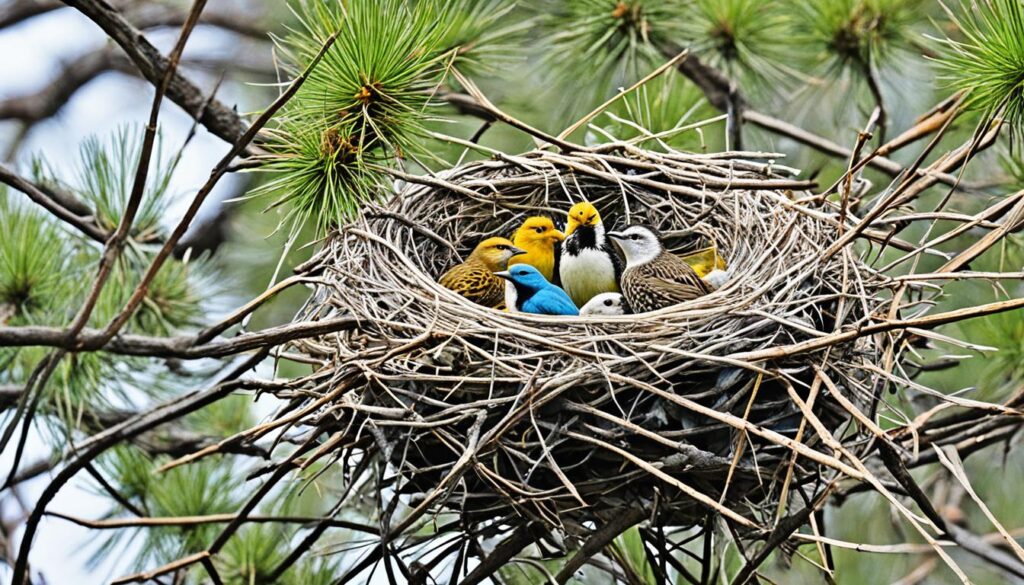
“The more I learn about birds, the more I realize how truly amazing they are. Their specialized nesting adaptations are a testament to the incredible diversity of the avian world.”
Conclusion
Bird nesting season is a very important time of year across the United States. It signals the peak of breeding and baby-raising for birds. The start and end of this season changes a lot. It’s based on where you live, the weather, and the kinds of birds around.
It’s key for everyone to know what birds need during this season. That way, we can all step up to help. Things like saving their living spaces, giving them food and water, or finding and telling where their nests are. Every little bit helps these birds a whole lot.
As we face issues like climate change, keeping bird homes safe is critical. It makes sure they have a good spot to nest without being bothered. This way, we protect the birds that bring color and song to our skies, making nature even more beautiful.
FAQ
When does bird nesting season typically occur in the United States?
In the U.S., bird nesting season usually runs from April 1 to August 31. The busiest time for nesting is roughly between April 15 and July 15.
How do factors like temperature, weather patterns, and migration affect the timing of bird nesting season?
Bird nesting times are mainly tied to temperature and weather. Warm spring temperatures kickstart the season, but too much change in weather can be bad. It might cause nest issues or a drop in babies born. Birds that migrate north plan their nests to match when food is plenty and the weather is best.
How does the nesting season vary across different regions of the United States?
The start and end of nesting seasons differ a lot across the U.S. This depends on the place’s latitude, climate, and local weather. In northern states, birds nest from mid-April to early August. In the south, it can begin as soon as March and last through September.
How can homeowners encourage nesting birds in their backyards?
You can attract nesting birds to your yard by offering the right spots for nests, like birdhouses or thick plants. Also, have food and water ready for them. Choosing the right spot for your birdhouse makes a big difference.
What are some ways to protect nesting birds and their habitats?
It’s vital to save nesting sites and protect them from human activity during the breeding season. Also, support efforts to keep their natural homes safe and help them grow.
How can individuals contribute to bird nest monitoring and conservation efforts?
Being part of nest spotting and bird care efforts is key to helping our feathered friends. Joining local bird watch groups or projects like NestWatch can give important insights. This data helps keep the birds safe and growing well.
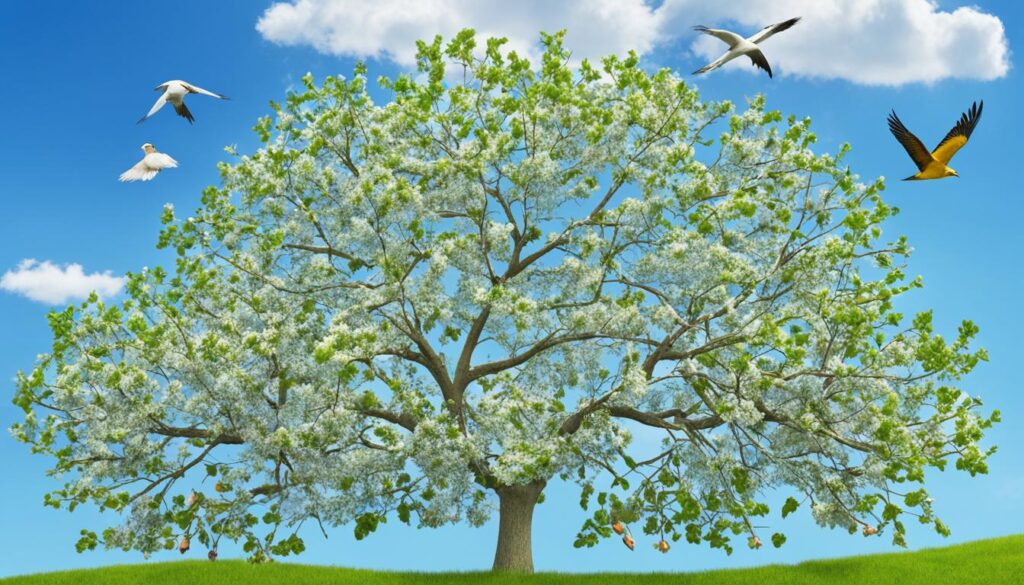

I’m extremely impressed with your writing abilities
and also with the format for your blog. Is this
a paid theme or did you modify it your self?
Anyway keep up the nice high quality writing, it
is uncommon to see a nice weblog like this one nowadays.
LinkedIN Scraping!